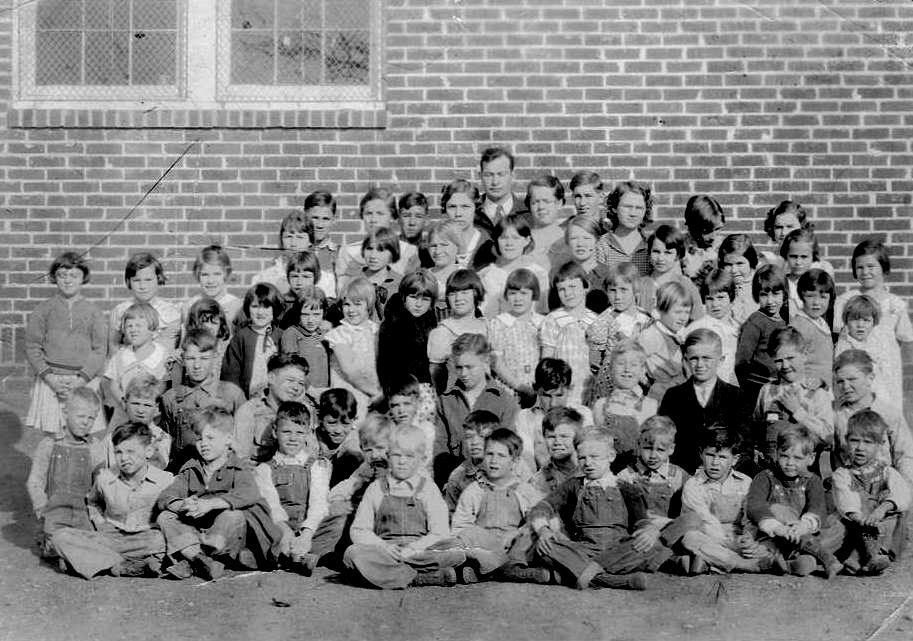
U.S. School: 20th Century Chronology--1930s Rural Schools

Figure 1.--This looks lik a 1st grade class at at a fairly large school to us dutung the 1930s. (There are some older children in the rear.) The large number of boys wearing overalls suggest that many of the students came from rural areas. Notice that the girls do not wear overalls. This is not a small rural school, but a large school in town with a mix of farm and town children. Also intereting is the number of girls with page/Dutch boy bangs--a whole class of Scouts and Walter Cunningham, Jrs. (Meaning characters in 'To Kill a Mockingbird'. That might have been a challenge.
|
|
There was still a huge differences in the 1930s betweem rural and urban schools. It might as well been a different country. This is clearly documented by the huge photographic record of school photography. You can always tell rural schols because of the number of boys wearing overalls. This was not the case in the 19th century. Overalls existed, but we do not see them being worn to school. Parents thought that children should dress up a bit for school. For reasons we do not fully understand, boys did not begin wearing overalls to school until the late-1900s. By the 1910s, overalls were almost a uniform at rural schools or small town schools with large rural student bodies. Many of the children at these schools were not affected by the fashion trends of the the 1910s-early 40s. This changed very rapidly after World War II. We are not yet sure why. We suspect that the trend to close small rural schools and bussing the children to larger schools with urban children was a key factor as well as rising farm income. The girls were different. They were much more affected by fashion trends. Some also wore overalls at least in the frm. Most girls were wore dresses to school. Here not obly were the conventions of the day at play, but primAry age girls tend to be more interested in fashion than boys at the same age. This all began in the late-1900s, but was still very much in evidence dring the 1930s. The Great Depression of the 1930s and impact on farm income only helped to perpetute this convention.
HBC-SU

Related Chronolgy Pages in the Boys' Historical Web Site
[Return to the Main American 20th century school page]
[Return to the Main American 1930s page]
[Return to the Main American 1930s Activities page]
[Return to the Main Chronology Page]
[The 1900s]
[The 1910s]
[The 1920s]
[The 1930s]
[The 1940s]
[The 1950s]
[The 1960s]
[The 1970s]
[The 1980s]
[The 1990s]
[The 2000s]
Navigate the Relate Boys Historical Clothing Style Pages
[Return to the Main U.S. country page]
[Long pants suits]
[Short pants suits]
[Lederhosen]
[Kneesocks]
[Eton suits]
[Jacket and trousers]
[Blazer
[School sandals]
Navigate the Boys' Historical Clothing School Uniform Pages
[Return to the Main U.S. School 1930s Chronology Page]
[Return to the Main U.S. School 20th century Chronology Page]
[Return to the Main U.S. School Chronology Page]
[Return to the Main U.S. School Page]
[Return to the Main National School Page]
[Australia]
[England]
[France]
[Germany]
[Ireland]
[Italy]
[Japan]
[New Zealand]
[Poland]
[Singapore]
[Scotland]
[Singapore]
Navigate the HBC School Section
[About Us]
[Activities]
[Chronology]
[Clothing styles]
[Countries]
[Debate]
[Economics]
[Garment]
[Gender]
[Hair]
[History]
[Home trends]
[Literary characters]
[School types]
[Significance]
[Transport and travel
[Uniform regulations]
[Year level]
[Other topics]
[Images]
[Links]
[Registration]
[Tools]
[Return to the Historic Boys' School Home]
Created: 1:58 AM 1/2/2016
Last updated: 1:58 AM 1/2/2016




